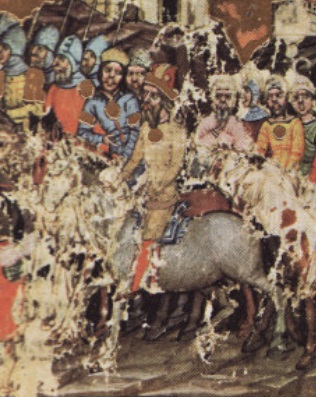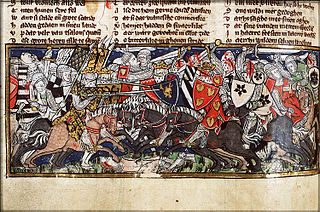Related Research Articles

Bleda was a Hunnic ruler, the brother of Attila the Hun.

The Battle of Nedao was a battle fought in Pannonia in 454 between the Huns and their former Germanic vassals. Nedao is believed to be a tributary of the Sava River.
The Akatziri, Akatzirs or Acatiri were a tribe that lived north of the Black Sea, though the Crimean city of Cherson seemed to be under their control in the sixth century. Jordanes called them a mighty people, not agriculturalists but cattle-breeders and hunters. Their ethnicity is undetermined: the 5th-century historian Priscus describes them as ethnic (ethnos) Scythians, but they are also referred to as Huns. Their name has also been connected to the Agathyrsi. However, according to E. A. Thompson, any conjectured connection between the Agathyrsi and the Akatziri should be rejected outright.

Balamber was ostensibly a chieftain of the Huns, mentioned by Jordanes in his Getica. Jordanes simply called him "king of the Huns" and writes the story of Balamber crushing the tribes of the Ostrogoths in the 370s; somewhere between 370 and more probably 376 AD.
Ascum was a general of the Byzantine Empire, active early in the reign of Justinian I. He was in command of the Praetorian prefecture of Illyricum. His name is reported by John Malalas. Both Theophanes the Confessor and George Kedrenos render his name "Ακούμ" (Acum).

Laudaricus was a prominent Hunnic chieftain and general active in the first half of the 5th century.
The history of the Huns spans the time from before their first secure recorded appearance in Europe around 370 AD to after the disintegration of their empire around 469. The Huns likely entered Western Asia shortly before 370 from Central Asia: they first conquered the Goths and the Alans, pushing a number of tribes to seek refuge within the Roman Empire. In the following years, the Huns conquered most of the Germanic and Scythian tribes outside of the borders of the Roman Empire. They also launched invasions of both the Asian provinces of Rome and the Sasanian Empire in 375. Under Uldin, the first Hunnic ruler named in contemporary sources, the Huns launched a first unsuccessful large-scale raid into the Eastern Roman Empire in Europe in 408. From the 420s, the Huns were led by the brothers Octar and Ruga, who both cooperated with and threatened the Romans. Upon Ruga's death in 435, his nephews Bleda and Attila became the new rulers of the Huns, and launched a successful raid into the Eastern Roman Empire before making peace and securing an annual tribute and trading raids under the Treaty of Margus. Attila appears to have killed his brother and became sole ruler of the Huns in 445. He would go on to rule for the next eight years, launching a devastating raid on the Eastern Roman Empire in 447, followed by an invasion of Gaul in 451. Attila is traditionally held to have been defeated in Gaul at the Battle of the Catalaunian Fields, however some scholars hold the battle to have been a draw or Hunnic victory. The following year, the Huns invaded Italy and encountered no serious resistance before turning back.
Kursich was a Hun general and royal family member. He led a Hunnish army in the Hunnic invasion of Persia in 395 AD.
Atakam was a young Hun prince who was impaled by Attila.
Mamas was a Hun royal family member who was impaled by Attila in Thrace.
Berichus or Berik was a Hun nobleman, ambassador, and lord, said to have "ruled over many villages".
Oebarsius or Aybars was a Hun nobleman, brother of Mundzuk and uncle of Bleda and Attila.
Scottas or Skottas was a Hun nobleman, ambassador and advisor. He was the brother of Onegesius.
Chelchal was a Hun commander serving as lieutenant general under the Byzantine Empire.
Ultzindur was a Hun nobleman and a blood relative of Attila.
Hormidac was a military leader of the Huns who commanded an expedition against the Eastern Roman Empire in the winter of 466/467. He raided Dacia mediterranea before being defeated by Anthemius.
Hyun Jin Kim is an Australian academic, scholar and author.
Vadamerca or Valadamarca may have been a Gothic princess and Goth royal family member by birth, and consort of the Rex Hunnorum Balamber, possibly the first ruler of the Huns. The only extant source that mentions her or Balamber is Jordanes' Getica, and it is possible that both are unhistorical.

Hunnic art covers all forms of art produced by the Huns, an extinct Central/Eastern Asian people, during their stay in Europe between c. 370 and c. 470 AD.
References
- ↑ Maenchen-Helfen, Otto J. (2022). Knight, Max (ed.). The World of the Huns Studies in Their History and Culture. University of California Press. p. 402. ISBN 9780520357204 . Retrieved 27 October 2022.
- ↑ Kim, Hyun Jin (2015). The Huns. Taylor & Francis. ISBN 9781317340911 . Retrieved 27 October 2022.
- ↑ Kim, Hyun Jin (2013). The Huns, Rome and the Birth of Europe. Cambridge University Press. p. 93. ISBN 9781107009066 . Retrieved 27 October 2022.
- ↑ Macartney, C.A.; Péter, László (2019). Studies on Early Hungarian and Pontic History. Taylor & Francis. ISBN 9780429515170 . Retrieved 27 October 2022.